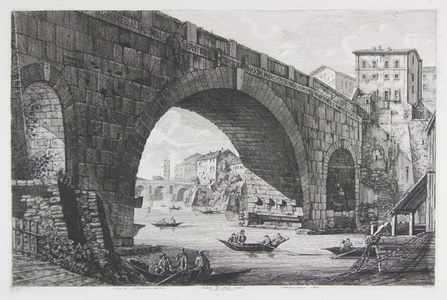| Method | Etching with engraving |
| Artist | Luigi Rossini |
| Published | Rossini dis. e inc. Roma 1822 |
| Dimensions | Image 352 x 540 mm, Plate 365 x 550 mm, Sheet 532 x 745 mm |
| Notes |
Inscription reads: 'A. Ponte rotto. B. Chiesa della Bocca della Verita. C. Fabbriche di Trastevere. D. Molini.' Plate 43 from Le Antichita Romane, ossia Raccolta della piu interessanti Vedute di Roma Antica, depicting the Bridge of Cestius, known commonly at the time as the Ponte Ferrato. Rossini's view of the bridge is almost identical to that of Piranesi from the Antichità Romane, even labelling and describing the factories of Trastevere and a chain-driven mill as Piranesi had done. The only minor difference is the view through the central vault of the bridge, where Rossini has labelled and described the Ponte Rotto ('Broken Bridge') and the Church of the Bocca della Verita. The Pons Cestius, was constructed during the late 1st century BC to link the Tiber Island to the Transtibertine bank. Similar to the Pons Fabricius on the east of the island, the bridge featured a large dedicatory inscription, the details of which can be seen in this view. The bridge was rebuilt and rededicated during the 4th century AD by the emperor Gratian, and by Rossini's era had been subject to numerous remodellings and additions. Most of the bridge was dismantled in the later 19th century to widen the river, though the current bridge makes use of much of the original structure. Le Antichita Romane, ossia Raccolta della piu interessanti Vedute di Roma Antica was Rossini's largest series of engravings, and the most popular with his clients. The 101 plates of views of the remains of Ancient Rome were completed between 1819 and 1823. The influence of Piranesi and the other great etchers of the 18th century is immediately apparent when looking at Rossini's work. In some cases, Rossini's perspectives match almost exactly those executed by Piranesi in the previous century, with an equal attention to architectural detail. As a result, the viewer is provided with a fascinating record of the changes wrought on Rome's most famous monuments in the time between the two artists. Luigi Rossini (1790-1857) was an Italian painter and etcher. Born in Ravenna, he studied art and architecture at the Academy of Bologna with Antonio Giuseppe Basoli and Giovanni Antonio Antolini. He graduated in 1813. Similarly to Giovanni Battista Piranesi, Rossini is best known for etchings of classical Roman architecture including the Pantheon, the Colosseum, the Appian Way, the Temple of Peace, and the Golden House of Nero. Rossini was also influenced by more rural settings, and produced etchings of the landscape surrounding Rome. His first series of views were published in 1814. He began his Roman antiquities series in 1819, completing 101 large folio plates which were published in Rome in 1825. Condition: Excellent clean impression. Light staining to right margin of sheet, not affecting plate or image. |
| Framing | unmounted |
| Price | £750.00 |
| Stock ID | 31410 |

